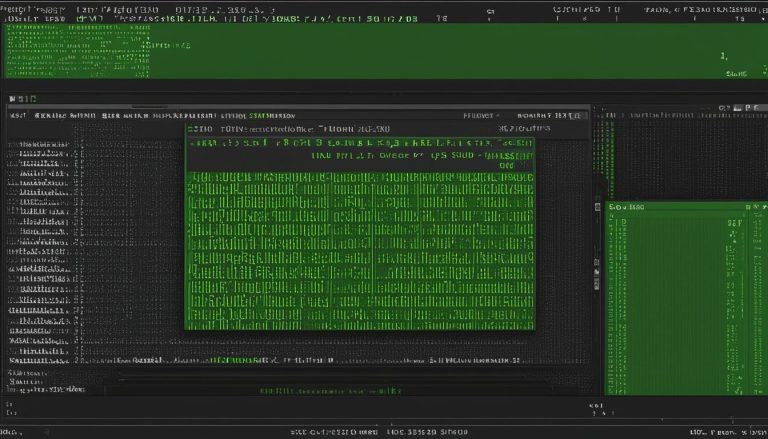Welcome to my article on Fedora, the popular open-source operating system developed under the Fedora Project. In this section, I’ll provide you with a simplified overview of what Fedora is and what makes it unique in the world of Linux. Let’s dive in!
Fedora, also known as Fedora Linux, is an open-source Linux-based operating system that is financially sponsored and supported by Red Hat. It is designed to be a secure, general-purpose OS that is constantly updated with the latest technologies.
Fedora is based on the Linux OS kernel architecture and offers a user-friendly experience with minimal friction. It is renowned for its frequent releases, launching a new version every six to eight months. This ensures users have access to the latest features and improvements.
With a wide range of applications, Fedora is widely used in various environments, including desktops, laptops, servers, and cloud computing.
Key Takeaways:
- Fedora is an open-source Linux-based operating system sponsored by Red Hat.
- It is updated frequently with the latest technologies and features.
- Fedora is known for its user-friendly experience and minimal friction.
- It is widely used in desktop, laptop, server, and cloud computing environments.
- Fedora offers a secure and stable platform for users.
Key Features and Benefits of Fedora
Fedora offers a range of features and benefits that make it a desirable choice for Linux users. It is a reliable and stable operating system that supports multiple architectures. Fedora is flexible and easy to use, with a user-friendly interface and a vast collection of software packages. It supports virtualization, multiple file formats, and many programming languages. Fedora also incorporates security features like Exec Shield and SELinux to protect user systems from malicious software. Additionally, Fedora updates automatically and provides tools for creating custom Linux-based distributions. It is suitable for web servers and allows users to test new software versions before deploying them in a production environment.
Fedora’s key features and benefits include:
- Reliable and stable operating system
- Support for multiple architectures
- User-friendly interface and extensive software package collection
- Virtualization support
- Compatibility with multiple file formats
- Support for various programming languages
- Incorporated security features like Exec Shield and SELinux
- Automatic updates
- Tools for creating custom Linux-based distributions
- Suitability for web servers and software testing
“Fedora offers a reliable and stable operating system with a user-friendly interface and extensive software package collection. Its support for multiple architectures, virtualization, and compatibility with different file formats make it a versatile choice. Additionally, Fedora’s built-in security features and automatic updates enhance the overall system protection. With tools for creating custom distributions and suitability for web servers and testing, Fedora provides flexibility and convenience for Linux users.” – Fedora User
Table: Comparison of Fedora Features
| Feature | Description |
|---|---|
| Reliability and Stability | Fedora offers a reliable and stable operating system. |
| Architecture Support | Fedora supports multiple architectures. |
| User-Friendly Interface | Fedora provides a user-friendly interface for easy navigation. |
| Software Package Collection | Fedora includes a vast collection of software packages. |
| Virtualization Support | Fedora offers support for virtualization. |
| File Format Compatibility | Fedora is compatible with multiple file formats. |
| Programming Language Support | Fedora supports various programming languages. |
| Security Features | Fedora incorporates security features like Exec Shield and SELinux. |
| Automatic Updates | Fedora updates automatically to provide the latest software versions. |
| Custom Distributions | Fedora provides tools for creating custom Linux-based distributions. |
| Suitability for Web Servers and Testing | Fedora is suitable for web servers and allows software testing. |
With its wide range of features, Fedora caters to the needs of diverse users, from developers and system administrators to enthusiasts and students. Its robustness, security, and user-friendly nature make it a favored choice in the Linux community. Whether it’s for personal use, software development, or running web applications, Fedora offers a reliable and flexible platform that keeps users at the forefront of innovation.
Fedora Editions and Installation Options
In order to cater to different use cases and preferences, Fedora offers five official editions: Fedora Workstation, Fedora Server, Fedora Cloud, Fedora IoT, and Fedora CoreOS. Each edition is designed to meet specific needs and can be downloaded for free from the Fedora website. Let’s explore the key features and use cases of each edition:
Fedora Workstation
The Fedora Workstation edition is tailored for laptops and desktops, making it an ideal choice for developers and software makers. It provides a comprehensive set of tools and an intuitive user interface, allowing users to efficiently pursue their coding and development projects. Fedora Workstation also includes popular software packages like GNOME, LibreOffice, and Firefox, ensuring a productive and seamless experience for users.
Fedora Server
For those managing infrastructure and services in data centers, the Fedora Server edition offers a flexible platform. It provides robust functionality and allows users to easily set up and manage various server roles. With Fedora Server, users have access to a range of server-oriented applications and tools, enabling them to effectively handle data center requirements.
Fedora Cloud
Fedora Cloud is optimized for cloud applications, making it the preferred choice for individuals and organizations leveraging cloud computing. It provides a lightweight and minimalistic environment, ensuring efficient resource utilization and enhanced scalability. Fedora Cloud also includes the necessary tools and frameworks for developing and deploying cloud-native applications.
Fedora IoT
As the name suggests, Fedora IoT is focused on building strong internet of things (IoT) solutions. It offers a secure and reliable operating system for IoT devices, enabling seamless connectivity and interoperability. Fedora IoT includes container support, allowing users to easily deploy and manage IoT applications in a containerized environment.
Fedora CoreOS
Fedora CoreOS is a minimal, container-focused operating system that is designed to be secure, reliable, and easy to manage. It includes the latest container technologies and features automatic updates, ensuring that users have access to the latest security patches and improvements. Fedora CoreOS is highly suitable for running containerized workloads in production environments.
Additionally, Fedora provides various Spins, Labs, and alternative downloads that offer customization options during the installation process. These options allow users to tailor their Fedora installations based on their specific requirements, such as choosing different desktop environments or installing specific software packages.
Now that we have explored the different editions and installation options available in Fedora, let’s move on to the next section to learn about the history of Fedora releases.
The History of Fedora Releases
The Fedora Project was founded in 2003 with the goal of making Red Hat software packages available to users. The first few Fedora releases, known as Fedora Core, were launched between 2003 and 2005. Subsequent releases introduced new features and improvements, with Fedora Linux 37 being the latest version as of January 2023.
Each release undergoes a six to eight-month development cycle, following the Fedora community’s “release early, release often” approach. The latest version includes updates such as Fedora CoreOS and Fedora Cloud, as well as various improvements in areas like neuroscience and virtualization. Fedora continues to evolve and incorporate the latest technologies for users’ needs.
To get a clearer picture of the history and evolution of Fedora releases, let’s take a look at the table below:
Fedora Release History Table:
| Release Version | Release Date | Key Updates |
|---|---|---|
| Fedora Linux 1 | November 6, 2003 | Initial release. |
| Fedora Linux 2 | May 18, 2004 | Introduction of Fedora Extras repository and yum package management system. |
| Fedora Linux 3 | November 8, 2004 | Improved package management and introduction of SELinux. |
| Fedora Linux 4 | June 13, 2005 | Enhancements in performance, security, and usability. |
| Fedora Linux 5 | March 20, 2006 | Improved hardware support and software updates. |
| Fedora Linux 6 | October 24, 2006 | Enhancements in desktop environments and package management. |
| Fedora Linux 7 | May 31, 2007 | Introduction of Fedora Electronic Lab and other new features. |
This is just a glimpse of the Fedora release history. Over the years, each release has brought significant advancements and improvements, making Fedora one of the leading Linux distributions in the open-source community.
Fedora vs. Other Operating Systems
When comparing Linux distributions, it’s essential to understand the differences between Fedora, Debian, Ubuntu, and OpenSUSE. While all four distributions share a common goal of providing a powerful and flexible operating system, each has its unique characteristics and focuses.
First, let’s look at package management. Fedora uses the RPM package manager and the DNF dependency resolver. On the other hand, Debian uses the DEB package format with dpkg and apt-get. Both package managers have their strengths and are widely used within their respective distributions.
“Fedora’s fast release cycle and open-source nature enable users to test and provide feedback on new features and updates.”
Another significant difference is the software repositories. Fedora has a single global repository with free software applications. Meanwhile, Debian offers a larger repository with various software packages, including both free and non-free options. This expansive repository allows Debian users to choose from an extensive range of software for their needs.
Regarding release models, Fedora follows a time-based release model, releasing a new version every six to eight months. In contrast, Debian focuses on stability and does not strictly adhere to a time-based release cycle. Ubuntu, derived from Debian, offers different flavors for specific purposes and aims to provide a user-friendly experience for desktop users.
Lastly, OpenSUSE, like Fedora, uses RPM as its package manager. However, it has a longer release cycle compared to Fedora, focusing on stability and enterprise use cases. OpenSUSE is known for its robust administration tools and strong community support.
In summary, Fedora, Debian, Ubuntu, and OpenSUSE are all reputable Linux distributions with their own strengths and focuses. The choice between them depends on individual preferences, specific use cases, and requirements. Whether it’s Fedora’s fast-paced development cycle, Debian’s extensive software repository, Ubuntu’s user-friendly approach, or OpenSUSE’s stability and administrative tools, each distribution offers a unique set of features and benefits.
Who Can Benefit from Fedora?
Fedora is a versatile operating system that caters to a diverse range of users. Whether you are a technology professional, a software developer, a digital artist, or a student, Fedora offers a host of benefits and features that make it a top choice for many individuals.
Technology professionals can leverage Fedora’s cutting-edge technologies and frequent updates to stay at the forefront of innovation. With its robust and reliable architecture, Fedora provides a stable platform for developing and deploying applications. Additionally, Fedora’s security features, such as Exec Shield and SELinux, ensure the protection of sensitive data.
For software developers, Fedora offers a comprehensive set of tools and programming languages, making it an ideal environment for coding and testing software. Fedora’s vast collection of software packages and its support for multiple architectures allow developers to create and customize their development environments.
Digital artists can benefit from Fedora’s powerful graphics capabilities and support for creative applications. Whether you’re into 2D or 3D design, animation, or visual effects, Fedora provides the tools and resources needed to bring your artistic vision to life.
Lastly, students can take advantage of Fedora’s user-friendly interface and educational software packages. Fedora is widely used in academic environments, providing students with a platform to explore and learn about various disciplines.
Common Fedora Users:
- Technology professionals
- Software developers
- Digital artists
- Students
Conclusion
In conclusion, Fedora is a versatile and reliable Linux-based operating system that offers a host of features and benefits. Whether you’re a technology professional, artist, developer, or student, Fedora provides a user-friendly experience that keeps you at the forefront of innovation.
With its frequent updates and commitment to open-source principles, Fedora ensures you have access to the latest technologies and security features. Whether you’re looking for a robust workstation, a flexible server, or an optimized platform for cloud applications, Fedora’s editions and installation options cater to your specific needs.
Compared to other operating systems like Debian, Ubuntu, and OpenSUSE, Fedora stands out for its flexibility, security, and customization options. Its fast release cycle and strong community make it a top choice for individuals seeking a powerful and reliable Linux distribution.
So, if you’re ready to explore the world of Fedora, download your preferred edition from the Fedora website today and embark on a journey of innovation and possibilities.
FAQ
What is Fedora?
Fedora is an open source Linux-based operating system developed under the Fedora Project. It is a secure and general-purpose OS that is constantly updated with the latest technologies.
Who sponsors and supports Fedora?
Fedora is financially sponsored and supported by Red Hat.
What are the key features of Fedora?
Fedora offers features such as multiple architecture support, a user-friendly interface, virtualization support, security features, automatic updates, and tools for creating custom Linux-based distributions.
How often are new releases of Fedora launched?
Fedora releases a new version every six to eight months.
What are the official editions of Fedora?
The official editions of Fedora are Fedora Workstation, Fedora Server, Fedora Cloud, Fedora IoT, and Fedora CoreOS.
Where can I download Fedora?
Fedora can be downloaded for free from the Fedora website.
What is the history of Fedora releases?
The Fedora Project was founded in 2003, and the first few releases, known as Fedora Core, were launched between 2003 and 2005. Subsequent releases introduced new features and improvements.
How does Fedora compare to other operating systems?
Fedora has its own characteristics and differences compared to other Linux distributions like Debian, Ubuntu, and OpenSUSE. Each distribution has its own strengths and focuses.
Who can benefit from using Fedora?
Fedora is suitable for a wide range of users, including technology professionals, developers, artists, academics, and students.
Hi, I’m Mark, the author of Clever IT Solutions: Mastering Technology for Success. I am passionate about empowering individuals to navigate the ever-changing world of information technology. With years of experience in the industry, I have honed my skills and knowledge to share with you. At Clever IT Solutions, we are dedicated to teaching you how to tackle any IT challenge, helping you stay ahead in today’s digital world. From troubleshooting common issues to mastering complex technologies, I am here to guide you every step of the way. Join me on this journey as we unlock the secrets to IT success.


